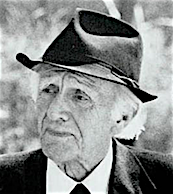
Eric Ross Arthur was born in Dunedin, New Zealand, on 1 July 1898 and received his initial training as an architect with Basil Hooper in Dunedin in 1916-17. In 1918, at the end of World War One, he enlisted with the New Zealand Rifle Brigade and went with them to England. With the war over, he remained in England and with the benefit of a Kitchener Scholarship, enrolled at Liverpool University School of Architecture in 1919. Arthur was one of 17 students whose drawings were selected for exhibition at Burlington House in London. His contribution received praise in The Architect, 18 February 1921 pp. 120-121, and The Builder 11 February 1921 pp. 182, 187 and 189.
After graduating with a B. Arch. in 1923 he worked briefly as an assistant to Sir Edwin Landseer Lutyens and Sir Aston Webb in London. Later that year, with William Naseby Adams, he entered and won two important architectural competitions - Britannic House for the Anglo-Persian Oil Company, and the Dewsbury War Memorial.
In September 1923 he accepted the post of lecturer in design at the University of Toronto, School of Architecture and in 1934 was appointed a full professor at the School. During his tenure he instigated a number of changes and was responsible for raising the profile of the School both in Canada and overseas.
In 1929 Arthur was granted a licence to practice in Ontario by the Ontario Association of Architects. He subsequently practised in Toronto for a number of years and was in partnership with Anthony Adamson from 1929 to 1934; William Eric Fleury, George H. Piersol and Robert Gordon Calvert from 1938 to 1949); and with Fleury and Stanley Bennett Barclay from 1949 to 1965. He also collaborated with other architects on various projects.
In addition to his work as an academic and practising architect, Arthur was the author of books and articles on architecture and architectural history including Small Houses of the Late 18th and Early 19th Centuries in Ontario (1929); The Early Buildings of Ontario (1938); Toronto No Mean City (1964); and The Barn: A Vanishing Landmark in North America (1972).
Among awards Arthur received were the University of Alberta Gold Medal for distinguished service to the arts and architecture in Canada in 1956; City of Toronto Award of Merit for distinguished public service in 1965; American Association of State and Local History Award for outstanding contribution to local history in 1965; Centennial Medal for Confederation Memorial Centre, Charlottetown in 1967; Canada Council Medal for outstanding cultural achievement in 1968); Companion of the Order of Canada in 1968); and honorary degrees from the University of Manitoba in 1959 and University of Guelph in 1981.
Arthur died in Toronto, Ontario on 1 November 1982
Kalman, Harold, et al. 'Eric Ross Arthur'. Architecture in Canada vol. 42, no. 2, 2017, pp. 3-86. [A special issue focussing on Eric Ross Arthur. Contents: 'Eric Ross Arthur: an introduction', by Harold Kalman and Rhodri Windsor Liscombe, p. 3; 'Eric Arthur's recording of the early buildings of Ontario', by Stephen A Otto, p. 5-7; 'Eric Ross Arthur: modernist architecture and the vernacular tradition', by Michelangelo Sabatino, p. 9-12; 'Assaying Eric Arthur's campaign to modernize Canadian design', by Rhodri Windsor Liscombe, p. 13-26; 'Eric Ross Arthur (1898-1982) - 'The educator: 'Modern thought ... built on society's needs'', by Angela Carr, p. 27-44; 'Eric Arthur and the introduction of modernism to Canada', by Harold Kalman, p. 45-70; 'Eric Ross Arthur: bibliography of his publications', by Angela Carr, p. 71-86].
'Eric Arthur Ross'. Keefer, Alec. Conservation in context : " ... to want a better city passionately" : an exhibition celebrating the life and achievements of Eric Ross Arthur (1898-1982. Toronto, Ontario: Market Gallery, 1998
Keefer, Alec. Eric Ross Arthur: conservation in context. Toronto, Ontario: Toronto Region Architectural Conservancy, 2001.
Sabatino, Michelangelo. 'Practical visions'. Canadian Architect vol. 47, no. 2, February 2002, pp. 22-23.
Sharples, Joseph, Powers, Alan and Shippobottom, Michael. Charles Reilly & the Liverpool School of Architecture 1904-1933. Catalogue of an exhibition at the Walker Art Gallery, Liverpool, 25 October 1996 - 2 February 1997. Liverpool: Liverpool University Press, 1996 pp. 165-166 [May contain other references to Arthur, unfortunately, the catalogue is not indexed]
‘Tribute to Eric Arthur on the 25th Anniversary of his arrival in Canada’ R.A.I.C. Journal vol. 24, February 1947 p. 63